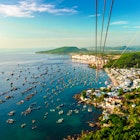
Once the capital seat for over a thousand years of the ancient Silla Kingdom, Gyeongju has long remained an important center of history and culture as well as a top destination for family vacations and educational school field trips.
Though in the past decade the city has undergone an exciting transformation. Technology and an emerging generation of movers and shakers have blended the city's long-standing traditional elements with modern-day aesthetics and trends to become a popular city for the young and hip.
Here's your guide to Gyeongju covering the must-visit neighborhoods, extraordinary attractions and a deeper dive into the increasingly diverse demographics worth exploring in this hidden gem city.
How to get to Gyeongju from Seoul
Gyeongju is located about 276km from Seoul but easily accessible via KTX (Koreaтs high-speed train) trains (about 2 hours), regular trains (about 3 hours) and buses (a bit longer than 4 hours). The ample transportation options help make Gyeongju a favorite for travelers looking to explore outside Koreaтs capital, regardless of oneтs budget or the amount of time they want to spend in this city.
Gyeongju City: a window to the past and the future

Although Gyeongju is about twice the size, in landmass, of Seoul, most of the popular attractions and sites are in the cityтs central area and easily accessible by local public transportation or even on a bicycle from the many rental shops around.
The buzzing Hwangridangil neighborhood
The area south of the major Taejong-ro (or Taejong Street), in the southern portion of Gyeongjuтs city center, is where many of Gyeongjuтs famous historic sites such as Wolji Pond and the Gyeongju National Museum are found. However, just west of the Daereungwon Tomb Complex, lies the mega-popular neighborhood of Hwangridangil where many picturesque hanok (traditional Korean houses) have been converted in the last decade into chic and social media-worthy cafes, restaurants, and shops. The name, Hwangridangil, is a play on the name of a neighborhood in Seoul called Gyeongridangil, the latter of which was, until recently, one of the hottest neighborhoods in the country. And although Seoulтs Gyeongridangil is no longer the shining destination it once was (done in by gentrification and the subsequent real estate prices that skyrocketed), Hwangridangil has, thus far, not suffered the same fate.
This popular neighborhood stretches across both sides of Poseok-ro which cuts across down Hwangridangil in the center. While restaurants and cafes are found throughout Gyeongju, itтs the charm of the countless hanoks (traditional Korean houses) in this area that gives Hwangridangil its quaint and unique vibe.
How to visit a Korean bathhouse for the first time
Here, new and old, eastern and western elements of design, cuisine, and aesthetics comes together so you can go from renting a hanbok (traditional Korean attire) to wear and explore the neighborhoodтs old alleys, stopping to sip coffee and enjoy desserts at a trendy cafУЉ like CafУЉ Neung, and enjoy craft beer and pizza at the trendy 987 Pizza while overlooking the royal tombs next door to it.
If you want to go a step further and live and breathe this history-meets-contemporary vibe as much as you can, you can opt to book your accommodation at the many renovated hanok stays where you can experience the beauty of these traditional Korean homes as locals did in yesteryears. If the thousands of social media posts from this area isnтt a sign though, Hwangridangil is usually packed with crowds of people and quite traffic-congested on weekends.
The more relaxed vibes of Gyochon Hanok Maeul
About 1km southeast of Hwangridangil, the Gyochon Hanok Maeul offers a more traditional, much quieter experience than Hwangridangil. This redeveloped traditional village was once home to the wealthy and noble Choi Clan, and you can still stop by the House of the Gyeongju Choi Clan to catch a glimpse of how this noble family once lived.
Around the area, you can spot many hipsters wandering this picturesque village in hanbok, taking pictures and partaking in the many traditional experiences offered on site. A handful of cute cafes and traditional restaurants serving a variety of Korean dishes can also be found around while unusual treats like injeolmi (a sweet roasted soybean powder dusted rice cake) ice cream are considered a must-try.

The stunning Woljeong Bridge nearby is not to be missed. The 66.15m long, bridge was originally built during the Silla Dynasty but was eventually lost to a fire. Using historical records, it was meticulously recreated and completed in 2018 to become the largest wooden bridge in Korea. The colorful, traditional Korean-style bridge is beautiful to visit day or night and has particularly become popular as a must-visit for young couples in love, including for engagement and wedding photos.

Bomundanji's resorts are the draw
This large-scale resort complex around the man-made Bomun Lake has been a popular tourist center, particularly with families, since the 1980s. Though located about 5km east of the city center, Bomundanjiтs location roughly about halfway between downtown and Bulguksa (or Bulguk Temple) and Seokguram Grottoтwhich are both Unesco World Heritage Sites and not to be missedтmakes it a popular choice to stay, as evidenced by the numerous hotels of varying classes built around the lake.
The endangered royal dogs of Gyeongju

The numerous attractions around the complex, like Gyeongju World (an amusement park) and Gyeongju Bird Park, are unapologetically geared towards out-of-towners, but they make for a welcome pit stop for some younger generations looking to catch a break from the historical and traditional elements of Gyeongju. Also scattered around the complex are a golf course, casino, water park and other entertainment venues, to offer a bit of something for every traveler type.
If Bomundanji's shine of tourism isnтt your thing, opt instead to rent a bike at the many rental shops around or take a walk around parts or all of the 9.2km road around the lake for a bit of nature. The lake is particularly beautiful in early spring, when the cherry blossom trees around the lake come into bloom.
Why South Korea is encouraging travelers to stay in Buddhist temples

Gyeongju's best bites
Trendy restaurants like Hwangridangil Anima and Seasoning in Hwangridangil almost always has a line of young people looking to enjoy dishes like pasta and steak in their unique and ambient settings. At these hot spots, the dishes aim to delight the eyes as much as the taste buds т as evidenced by all the diners taking photos. If youтre searching for a simple snack, local chain Gyori Gimbap is one of the cityтs best-known quick bites. Operating multiple outlets around the city, they serve the popular snack of kimbap (seaweed rolls stuffed with rice and various fillings) stuffed with their trademark ribbon thread eggs.

The Korean beef of Hanwoo is well known from Gyeongjuтs surrounding province and young and old alike flock on weekends to local institutions like Twoegeungil Sootbool Galbi for Hanwoo bulgogi, ribs and other standard Korean barbecue fare.
Another popular choice is Hamyangjib, said to have been operating for over 90 years, where the hanwoo mool hwoe, beef tartar served in a chilled broth with noodles is worth the wait. Be forewarned that these popular spots, especially the latter, are known to have wait times of one and half to two hours on weekends.
Safety recommendations and restrictions during a pandemic can change rapidly. РЯАФУХСљКЯВЪПЊНБМЧТМ recommends that travelers always check with local authorities for up-to-date guidance before traveling during Covid-19.
Gyeongju City is on our 2022 Best in Travel list. For more stories from some of the worldтs most exciting destinations click here.
You might also like:
Top 30 free things to do in Seoul
Seoul's best autumn walks
KFC: a guide to eating Korean fried chicken in Seou
Explore related stories


 Tips & AdviceJapan vs South Korea: which impressive East Asian destination should you visit?
Tips & AdviceJapan vs South Korea: which impressive East Asian destination should you visit?Nov 19, 2024 тЂ 8 min read



 ActivitiesРЯАФУХСљКЯВЪПЊНБМЧТМ's guide to visiting a Korean bathhouse for the first time
ActivitiesРЯАФУХСљКЯВЪПЊНБМЧТМ's guide to visiting a Korean bathhouse for the first timeJun 19, 2024 тЂ 8 min read




